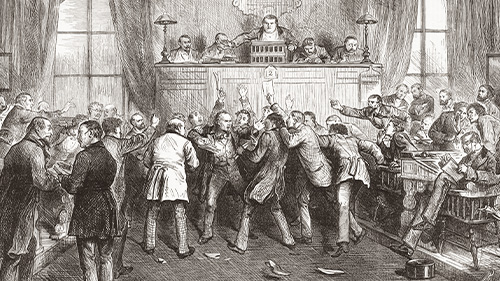Mastering the FRQ on the AP U.S. Government and Politics Exam
The argumentative essay question on the AP U.S. Government and Politics exam demands a synthesis of content knowledge, analytical skill, and...
AP & Honors Mathematics
Explore Wiley titles to support both AP and Honors mathematics instruction.
Literacy Skills & Intensive Reading
Connections: Reading – Grades 6–12
Empower student success with a proven intensive reading program that develops strong reading skills in striving readers.
Drama, Speech & Debate
Basic Drama Projects 10th Edition
Build students’ confidence and competence with comprehensive, project-based theatre instruction.
Literature
Connections: Literature
Support learners as they study dynamic, relevant texts and bring the richness of diverse voices to students through literature.
Literature & Thought
Develop critical thinking, reading, and writing across literacy themes, genres, historical eras, and current events.
Language Arts
Vocabu-Lit® – Grades 6–12
Help students build word power using high-quality contemporary and classic literature, nonfiction, essays, and more.
Connections: Writing & Language
Help students develop grammar, usage, mechanics, vocabulary, spelling, and writing and editing skills.
Reading/English Language Arts
Measuring Up to the English Language Arts Standards
Incorporate standards-driven teaching strategies to complement your ELA curriculum.
English Language Learners
Measuring Up for English Language Learners
Incorporate research-based best practices for ELLs with an approach that includes a focus on language acquisition strategies.
Mathematics
Measuring Up to the Mathematics Standards
Incorporate standards-driven teaching strategies to complement your mathematics curriculum.
Foundations
Measuring Up Foundations
Help students master foundational math skills that are critical for students to find academic success.
Science
Measuring Up to the Next Generation Science Standards
Give students comprehensive NGSS coverage while targeting instruction and providing rigorous standards practice.
Assessment
Measuring Up Live
Deliver innovative assessment and practice technology designed to offer data-driven instructional support.
For a better website experience, please confirm you are in:

You may have heard about the “Irish” Thesis Formula—it is all over the internet. Some teachers like it, others hate it, but whatever you think about it, it works as a strategy for helping students set up a complex essay. The argument against it?It is too complex and asks students to do way too much for the thesis point on the AP exam. The argument for it? It is simple, straightforward, and gives guidelines for struggling students (and teachers) to help them set up a thesis for a complex essay.
Before we look at the strategy, let’s take a look at the expectations from the College Board with regard to the thesis point. First, the thesis point represents one point on the rubric for both the long essay question and the document-based essay question. Second, it asks each student to respond to the prompt with a historically defensible thesis/claim that establishes a line of reasoning. Third, to earn the point, the thesis/claim must respond to the prompt rather than restating or rephrasing the prompt. It must consist of one or more sentences located in one place, either in the introduction or the conclusion.
First, establish a line of reasoning; second, must respond to the prompt (not restating or rephrasing it—as a side, many of the critics of the “Irish” Thesis Formula argue that it is too complex, but then they go on to offer a thesis which only restates or rephrases the prompt).
Evaluate the relative importance of the causes which led to the American Revolution.
This is a good causation prompt, straight forward and mimics the wording that College Board uses for these types of prompts. If we had a thesis which said the following: There were many causes which led to the American Revolution. This would not get the thesis point, because it does not offer a line of reasoning and it simply restates the prompt. What if the thesis was:
Many political, economic, and social causes led to the American Revolution.
This also would not get the point, because it is too generic; in other words, it really does not tell me anything about the essay I am getting ready to write (a thesis must be a guide, a roadmap to the essay), I assume there are political, economic, and social causes which led to the American Revolution. This is really not much better than the first prompt. It’s better, it is moving us in the direction toward an acceptable thesis, but it does not go far enough: it does not establish a line of reasoning and does little more than restating the prompt.
The “Irish” Thesis Formula is simple:
X. However, A & B. Therefore, Y.
Each of these letters represents an important part of a successful thesis.
What each of these stands for is: X represents a counter-argument; A and B represent your two strongest points; and the Y represents your position (or stance) about the prompt.
It is important to keep in mind that each essay prompt (including LEQs and DBQs) will ask you to create and make an argument. None of them are simply asking you to identify or describe items. So, going back to the prompt we looked at: “Evaluate the relative importance of causes which led to the American Revolution.” There is an argument built into this prompt. It is not simply asking you to identify the causes that led to the American Revolution; instead, it is asking you to identify and rank the causes that led to the American Revolution. The wording “evaluate the relative importance of the causes” keys you to think about not only what the causes were, but also the relative importance of these different causes. So the argument here will be what do you think were the most and least important causes. For illustrative purposes, we will go with the following: X represents the least important cause, and A and B will represent the two most important causes.
One note before we look at a possible thesis, we should try and avoid proper nouns within your thesis. Proper nouns are evidence; evidence belongs within body paragraphs, not in thesis statements.
So if I had a thesis that said:
The Stamp Act was an important cause. However, the Quartering Acts and the use of Admiralty Courts were more important causes which led to the American Revolution.
Is this a good thesis? Does it satisfy the “Irish” formula? It does and would probably get the thesis point at the reading. However, it violates a major rule about good writing: you do not generally use evidence within your thesis. It would be like a lawyer using all the pieces of evidence that they were going to employ within their case, all within the opening statement. Probably not a good strategy.
So, how can we write the thesis, not using any proper nouns, and still keep the essence of the argument presented in the thesis that I provided initially?
Here might be a better approach:
British economic policies placed significant burdens on the American colonies and fueled widespread frustration. However, it was the political policies—seen as direct violations of the colonists’ rights as English citizens—that were perceived as more threatening. Therefore, these political grievances played a more decisive role in sparking the American Revolution.
Can you see the difference between the first two thesis statements, which were viewed as problematic, versus this third thesis statement? Notice that the third thesis, the acceptable one, does not use the terms “political” and “economic,” nor does it give away its evidence within the thesis, but it does give the reader a clear idea of what they are going to argue within the essay.
Let’s take a look at another type of essay prompt, a continuity and change over time essay prompt. Along with the causation essay prompts, it has been very popular on the AP History exams.
Suppose we have the following prompt:
“Evaluate the extent of change in the lives of women in the United States from 1800 to 1860.” Remember what I said before, every prompt will ask you to construct an argument, not simply to describe some historical information. So with this prompt, you do need to know historical information about the lives of women in the United States during the time period. But it is not simply asking you to just do a laundry list of all the information you know about women during this time period. Instead, it is asking you to determine whether you believe there were more continuities or changes in the lives of women during the period. That is the argument that you are going to make, were there more changes or more continuities within the lives of women in the United States during the time period 1800-1860.
So an unacceptable thesis might look like this:
There were many changes in the lives of women in the United States from 1800-1860. This fails because it does not either establish a line of reasoning nor does it do anything other than simply restating the prompt. Similarly, the following thesis is also unacceptable: There were lots of economic and political change that took place within the lives of women in the United States during the period 1800-1860. Additionally, the following thesis will also be considered unacceptable (even though it does follow the “Irish” Thesis Formula): The Seneca Falls Convention was a great point for women, bringing awareness to their political struggles. However, the ideas of Republican Motherhood and the Cult of Domesticity both were used to forbid women from breaking out from their traditional roles. Therefore, while there were some changes, women’s lives experienced much more continuity within the United States from 1800-1860.
While it does follow the “Irish” Thesis Formula, and the student clearly knows a lot and understands some of the nuances of the essay prompt, this is a thesis that gives away too much within the thesis. All of those pieces of evidence (i.e., proper nouns) should be saved for the evidence to be used within the body paragraphs.
What might a complex thesis look like, while maintaining the proper balance of evidence usage and too generic statements?
Women in the nineteenth century used various political avenues to raise awareness about their status. However, deeply rooted social beliefs about traditional family roles had a far greater influence on their daily lives. Therefore, despite some opportunities for political expression, women in the United States between 1800 and 1860 faced limited opportunities overall.
Again, notice that this thesis presents an argument, while not providing all the evidence that is to be used within the body paragraphs. This thesis, using the proper “Irish” Thesis Formula, sets up the essay for a complex argument, which can lead to additional points within the College Board rubric. It also demonstrates a better way of writing and setting up an argument, so writing in my class is not just about getting points on the College Board rubrics; it’s about developing complex ideas and becoming a stronger writer across the board.

The argumentative essay question on the AP U.S. Government and Politics exam demands a synthesis of content knowledge, analytical skill, and...

Guide students through an engaging activity that stresses the importance of the thesis & topic sentences to structure the line of reasoning. Students...

The Long Essay Question (LEQ) on the AP U.S. History exam offers students an opportunity to construct a sophisticated historical argument, supported...

Do you need ideas or extra support helping students review for the AP® United States History Exam? Join me as I share my content review resources and...

One of the things that I spent most of my time thinking about, when the redesigned AP U.S. History course went into effect, was how to deal with the...

Early in a school year it can be a real challenge to know how to begin teaching students critical skills they need to score on the AP® U.S. History...

From a practical point of view, argumentation is at the heart of the free response section of the AP exam. This can be particularly difficult with...

Join AP experts Brandon Abdon, Colin Baker, and Bob Topping to discover scaffolded approaches to teaching the APUSH, AP Euro, and AP World History...

Experienced AP World History teacher Dave Drzonek and AP World History Exam table leader Charlie Hart discuss what students did well and what they...

It’s the time of year when teachers and students begin their final push towards preparing for the AP Human Geography exam. Teachers and students...

Unlock the power of historical thinking and writing as you elevate complexity and engagement in AP History classrooms. Presented by experienced AP...

There is less than a month until the AP® Econ exams. It is crunch time for students—especially those taking multiple AP®exams. These exams can be a...
